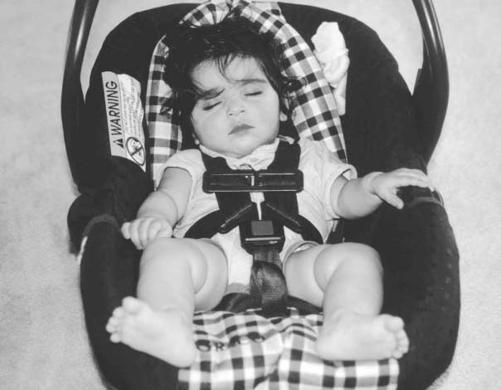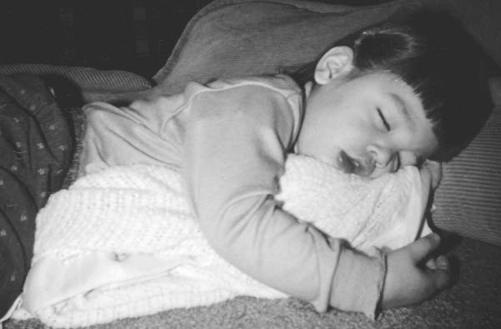The No-cry Sleep Solution (39 page)
Read The No-cry Sleep Solution Online
Authors: Elizabeth Pantley



Review and Choose Sleep Solutions
115
and find it easier to go back to sleep. (This is an especially important idea if you’ve attempted to let your baby cry it out in the past. It can help banish any negative memories and replace them with a sense of peacefulness about being in the crib.)
Falling Asleep in Different Ways
Right now, your baby may fall asleep in only one way, such as nursing, rocking, or having a bottle. This activity is a very powerful signal that your baby associates with falling asleep. It is so powerful that he may believe that the only way he
can
fall asleep is when this signal is present.
Mother-Speak
“Emma has always fallen asleep breastfeeding. Once in a while my sister baby-sits her while my husband and I go out. It never fails that she’ll be wide awake when we get home, no matter how late. My sister says she tries everything, but the little stinker waits until I walk in the door. Two minutes of nursing and she’s sound asleep.”
Lorelie, mother of six-month-old Emma
If your baby relies on one specific signal to fall asleep, you can help her change this association and learn that she can fall asleep in different ways.
If you choose to follow this suggestion, creating and following nap- and bedtime routines prior to sleep, as discussed earlier in this chapter, will help. But the final step occurs in different places.
Usually, it’s easier to begin this plan with naps before tackling nighttime. Does your baby fall asleep in the car or swing? While rocking, using a pacifier, or walking in the stroller? Find and use


116
The No-Cry Sleep Solution
Areesa, eight months old
alternative ways to help your baby to fall asleep for naps. If possible, use two methods. Try to get her comfortable with a variety of ways to fall asleep. One day, go for a ride in the car. The next day, put her in a swing. The third day, rock her. After you have done this for a week or more, you can begin to use your alternate
“signals” to bring your baby to a very sleepy state, and then move her quietly to her bed.
At this point, stay with your baby, and pat or touch her in the way that is soothing. If you have been using a nap routine and watching her signals, she should then be able to fall asleep on her own. If she doesn’t, go ahead and use the method that works best.
Your goal, after all, is for your baby to take a nap.
You may then gradually shorten your routine until it is comfortable for both of you. Once your nap schedule is in place, and


Review and Choose Sleep Solutions
117
your nighttime sleep is settling down, you can eliminate all those alternate methods for falling asleep and use the one that is most convenient for you.
Introduce a Lovey
This idea may help everyone.
Some babies attach themselves to a blanket or toy that becomes a “lovey.” This is a transitional object that comforts your baby in your absence. In some cases, you may be able to help your baby become attached to a lovey or comfort object so that he has something to cuddle and help him fall asleep without your help.
A lovey does
not
take your place. Instead, it is something that your baby can use to feel safe when you are not with her. Interestingly, only one of my children discovered her own lovey: my award-winning-sleeper baby, Vanessa. Appropriately enough, her lovey was a red pillowcase named Pilly. Oh, did I say
was
? At twelve years old, Pilly still holds a place of honor in her bedroom, functioning not so much as a lovey, but as a sweet reminder of when she was little. Angela and David had favorite cuddly toys, but none that would qualify as a lovey. With Coleton, I was able to encourage his attachment to a lovey. It wasn’t nearly as intense as with Vanessa, but it became a sleep cue and was a helpful piece of the whole sleep plan that I created for him.
Some children adopt a lovey in babyhood and continue to use it all through childhood. Others switch to a new lovey from time to time, other children find solace in any soft, fuzzy toy, and some never do take to the idea of a lovey. You’ll be able to tell which category your child fits in by watching his actions.
Choose a Safe Lovey
Choose a soft toy that your baby is already attracted to, or pick a safe stuffed animal that meets these criteria:


118
The No-Cry Sleep Solution
Emily, twenty-four months old
• No button eyes or nose, nor any small, potentially removable pieces
• No clothes, hats, or other removable pieces of fabric
• Firm, not floppy
• Small and easy for baby to hold and manipulate
The ideal lovey is a stuffed animal created especially for babies.
For example, I purchased a little flannel doll called a “Snoedel”
(snoedel.com) for Coleton. (Please note that I have no affiliation with this business other than as a satisfied customer.) After he became accustomed to having it in bed, he let us know that he was tired by asking for his “noodle.” (Or we would encourage him to
get
tired by cuddling him with his “noodle.”) When you have carefully chosen the lovey, place it between the two of you whenever you nurse your baby, give him a bottle, or rock him. At other times of the day, you might even want to
“wear” this lovey inside your shirt for a few hours to give it that lovely Mommy (or Daddy) smell, because babies can recognize
